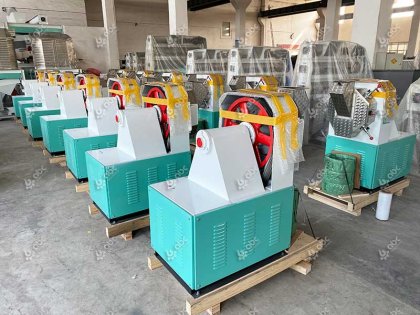As the government and industry stakeholders move towards a low-carbon economy, the replacement of coal with renewable energy will become the key. Among them, bamboo can be harvested 4 times a year, and the world has an area of millions of hectares. For a long time, the research and utilization of bamboo have involved timber use, bamboo shoots, paper-making, and so on. Bamboos are characterized by fast growth and strong adaptability. This means that bamboo will be an ideal sustainable biomass fuel.

Bamboo Pellets Made By Biomass Pellet Production Line
Bamboo Pellet Production Process

Bamboo Pellet Processing Process
Bamboo pellets are small and often look like enlarged capsules. They are shinny with an appearance of a furnished piece of wood. The pellet production process usually includes crushing, drying, pelletizing, cooling and storage.
-
Crushing is used to break the thick and long bamboo stalks into small pieces by use of a Chipper and into powder by use of a Hammer Mill. But before the beginning of the crushing process, one needs to separate the bamboo materials from dust and debris. Thereafter, the stalks and leaves can be crushed into powder.
-
After the crushing process, a Rotary Dryer is required for the drying process in order to ensure that the dried powder has a moisture content of less the 10 percent.
-
The pelletizing process will see the compression of the dried powder into pellets at high speeds and high pressure. A pellet presser or pellet making machine is required for this process. You can use a household bamboo pellet mill for domestic purposes or an industrial bamboo pellet mill for large scale commercial production.
-
Note that palletization usually leaves the pellets with high temperatures hence there is need to cool them down in order to maintain their quality and durability. A Bamboo Pellet Cooler is used to cool down the pellets’ temperatures.
After all the processes above, the pellets can now be packaged and stored for use.
Bamboo pellets Advantages
-
Bamboo pellets can be used as a source of a renewable energy source .There is an increasing shortage of traditional energy sources such as gas and coal and bamboo pellets can be used to produce biomass fuel. Compared to gas, oil and electric heating, these pellets can save up to 50 percent of your energy costs.
-
Low emission. Bamboo pellets are environmentally friendly and after being processed, they contain less than one percent of ash. Ash plus the little Sulfur content produce very little burning emission hence reducing the greenhouse effect and acid rain.
-
They have a high heat value. The pellets have a fuel value of around 4800 kcal which is equal to the heat value of coal, but with much less space occupation.
-
The pellets have a wide range of uses. They can be used in cooking, heating, industrial steam furnace among others.
-
They are safe and convenient for transport and storage. The pellets are light in weight and they can be stored for a very long time.
Uses of Bamboo Pellets
In the 21st century, mankind is facing severe challenges from energy issues, and global energy policy is undergoing a decisive turning point. Renewable energy such as biomass is gradually replacing fossil energy, not only in countries with energy shortages, but also energy-rich developed countries are quietly adjusting energy policies, vigorously researching and developing new clean energy, and promoting the transformation of energy consumption structure from single to diversified , Taking the road of multi-energy complementary and comprehensive utilization, mankind is beginning to enter the era of renewable energy.
| cellulose | 50.38% |
|---|---|
| hemicellulose | 23.86% |
| lignin | 25.45% |
Bamboo plants are a kind of renewable biological resources with multiple uses. How to make full use of the abundant bamboo resources has attracted increasing attention.
- As a source of biomass energy production. They can be used in industrial steam furnace, heating and cooking.
- They can be used for Medicinal extracts.
- As animal feed. They have a crisp nature, light sweet flavor as well as exceptional nutritional value.
Compared with other plants, bamboo plants have the characteristics of many varieties, fast growth, strong regeneration ability, and sustainable management and utilization after successful afforestation. In addition, bamboo plants have low ash content and high cellulose content, making them very suitable for growth. Material raw materials. In addition, 60% of the bamboo production and processing are processing residues. How to make full and effective use of these wastes has become an urgent problem in the comprehensive utilization of bamboo.





















